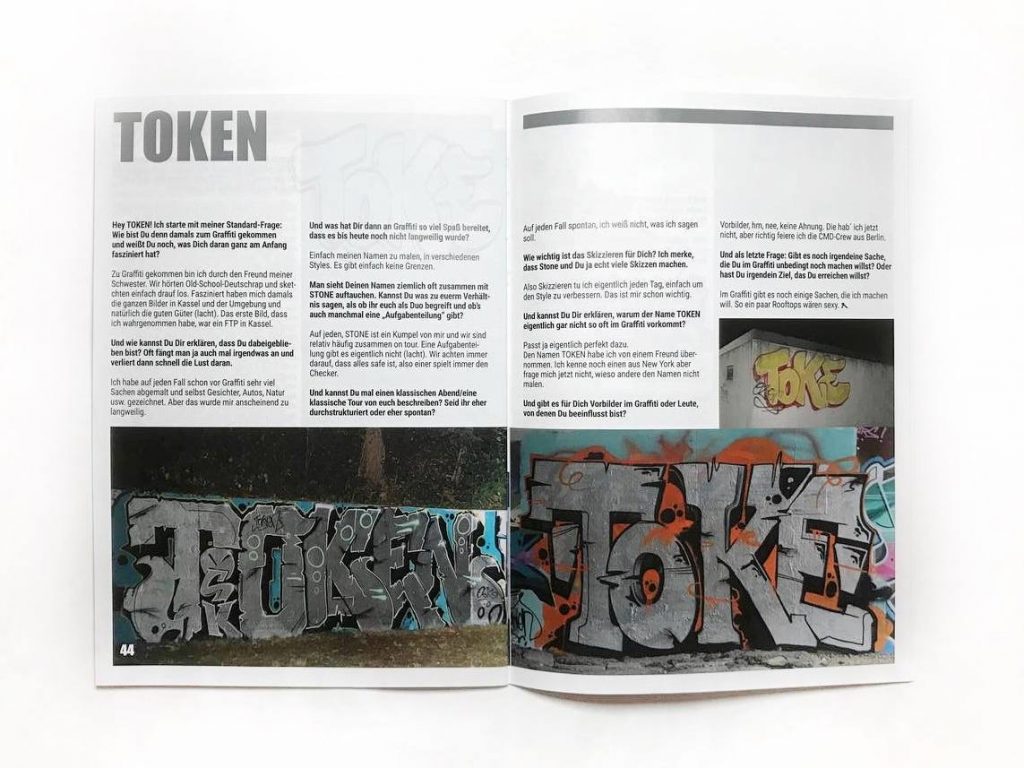Located in the German federal state of Hesse, you could probably be forgiven for not having heard of the modest town of Kassel (although regular readers of Graffiti Review may recall the region from previous posts). ASAP Legends is a bit of a novelty in that it unashamedly covers newcomers to the streets of Kassel. Now, my immediate question on picking this magazine up was “is this just a load of toys?” However the magazine is built around a novel concept that unites newcomers to graffiti with old hands who are merely new to their adopted town. The publication is structured as a series of interviews with individual writers about their experience of the graffiti scene in Kassel. The result is a fairly text heavy publication, all in German, accompanied by a cool variety of styles and surfaces.

ASAP Legends contains a fairly diverse line-up of graffiti writers one of whom is Elf who describes themselves as a passionate tagger. So far so good! Turn over the page and the reader is met with the Xanie funk from clean throw-ups to some more trashie, yet legible, styles that the painter says are an attempt to evoke break-dancing. Meanwhile Bone, as an already accomplished train writer, is featured as a newcomer to the local scene. Asked about their observations of graffiti in Kassel, Bone notes that anti-style is dominant but for them it’s the geography of the place which makes it special – alongside the trams, of course! Another interviewee, Frei83, who has made Kassel their home merits a mention too as their style is just so nice to look at.
Aside from the peculiarities of the graff scene in Kassel itself, ASAP Legends also explores wider themes and issues related to contemporary graffiti. These range from issues of gender, religion, mental health, history, and technology. For example, the editor asks one interviewee, Line, about how her gender may have impacted her graffiti. Line is surprisingly laconic however, suggesting that sexism has not really been a personal issue whilst doing graffiti. Meanwhile, Tylyt explains that they actively avoid being labelled with any particular identity be it that of an ‘antistyler’ to gender binaries. The result is that their shadowless letters stand out and can be recognised as their own.
Now, the refrain that the internet has ‘ruined’ graffiti is hardly new.
Something else that comes through is the different routes into graffiti that people now have. Explaining their introduction to graffiti Frei83 describes friends who were b-boys and the role of hip-hop culture growing up. Likewise Juwel also points to hip-hop while Etak mentions skateboarding and even football as influential. In contrast, Line points to Instagram as an influential media that got them into painting. Now, the refrain that the internet has ‘ruined’ graffiti is hardly new. And there’s certainly a case that it has allowed certain graffiti artists ‘cheap fame’ and has made styles, that once were distinctively local, blandly homogeneous. And yet, the internet has opened up graffiti to a mass audience like never before. Scrolling through the seemingly limitless graffiti content on Instagram can be an instantly forgettable experience but there’s magic there too.

The final word in ASAP Legends however goes to someone who has been doing graffiti long before it hit the internet or even came to Europe. The last surprise article is about the legendary Cornbread from Philadelphia! The interview actually came about as a gift of social media and, while Cornbread isn’t associated with Kassel, I guess the interview feeds into the global history of graffiti. Indeed, when asked, the editor of the magazine confirmed that this final interview was included as a deliberate juxtaposition between Kassel’s newcomers and the wider history of the subculture. But aside from all that, it’s just a pleasure to read! There are further issues of the magazine planned, with the possibility of a long-term project that returns to the original interviewees at a much later date, but while there’s only a limited run of this first one it’s a case of get it while you can!